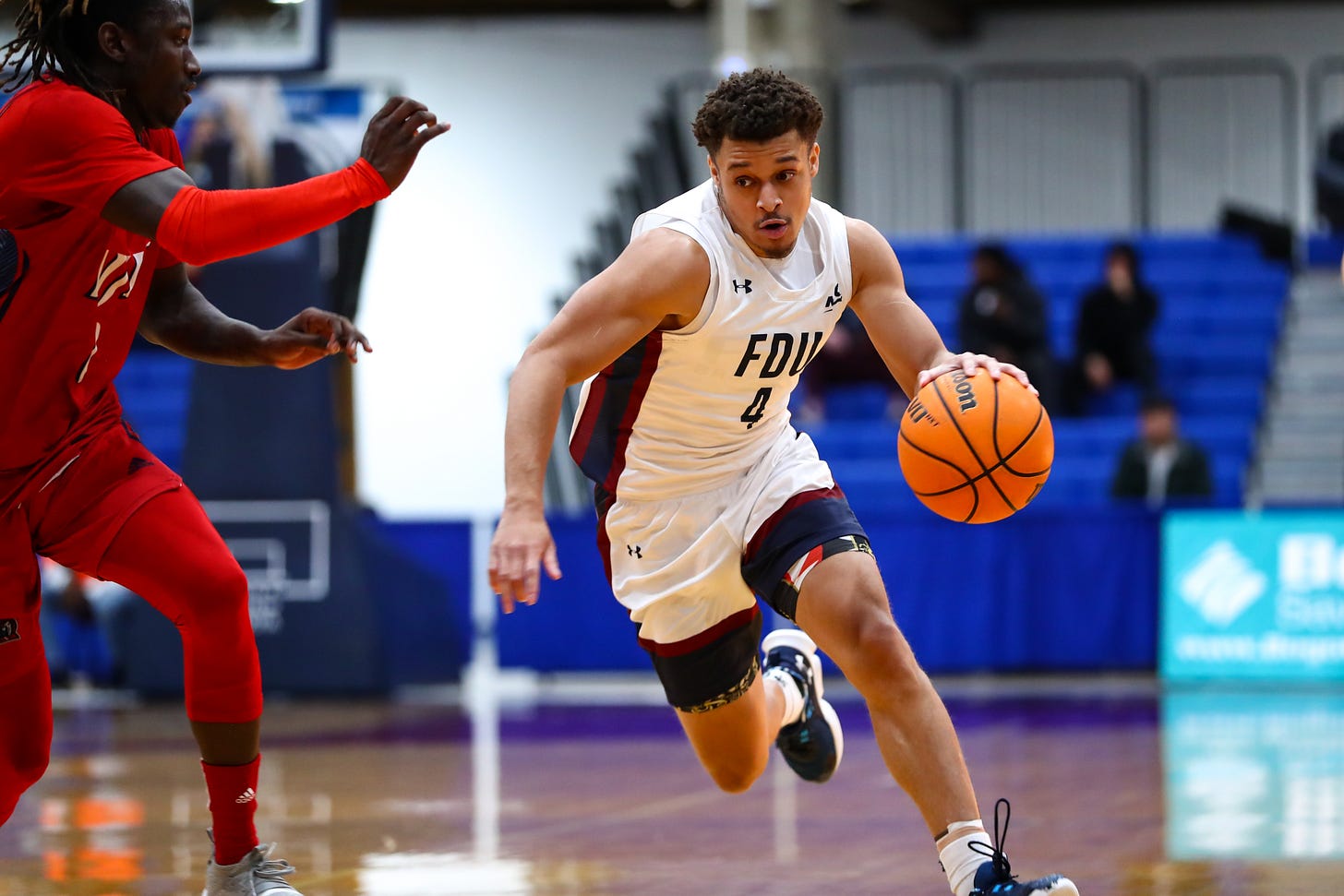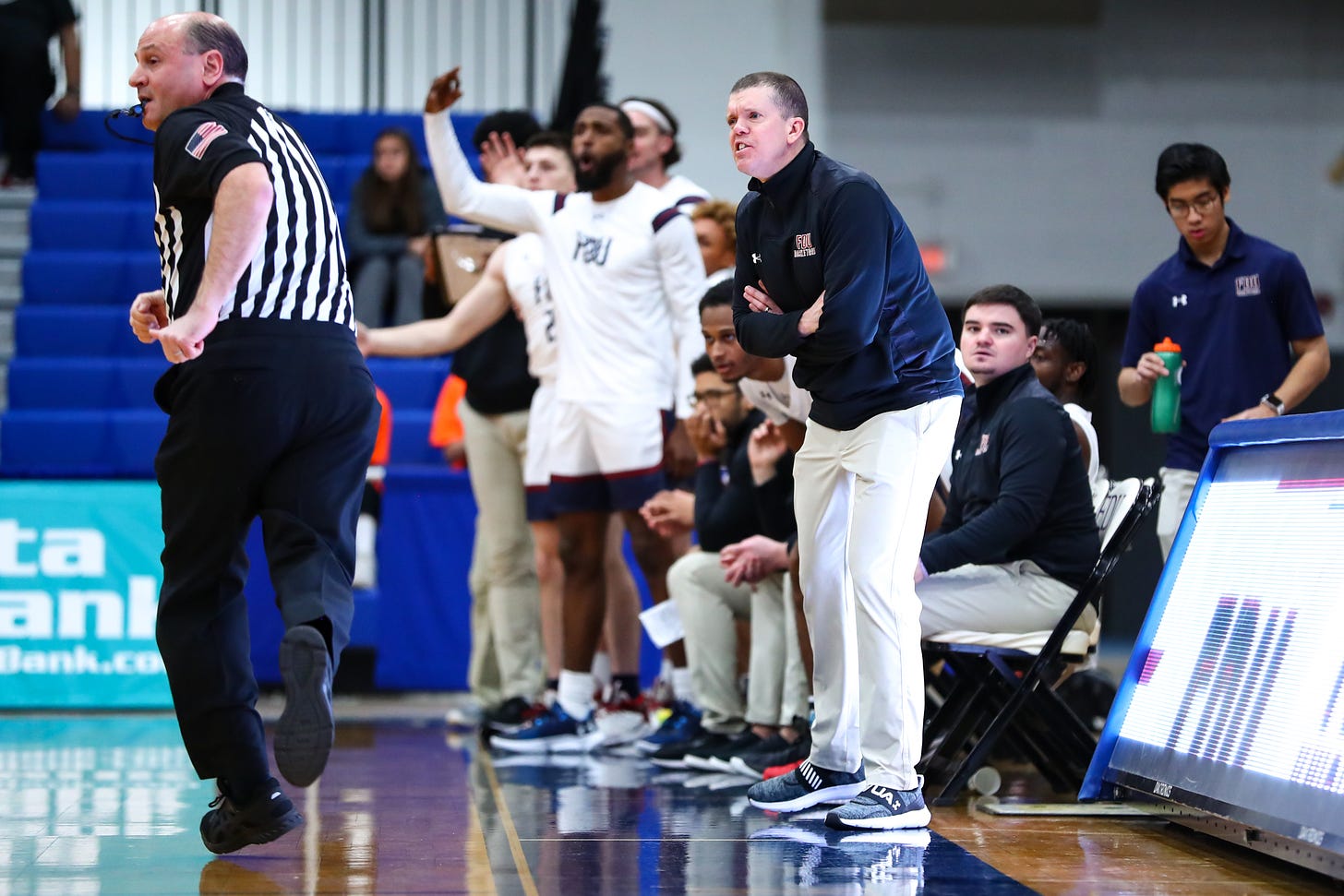Fairleigh Dickinson’s turnaround fueled by toughness, tempo and no blinking
Up-tempo offense is a major reason why first-year coach Tobin Anderson and FDU have enjoyed a speedy turnaround from 4-22 last season to a 10-8 start in 2022-23.

HACKENSACK – It’s rare to see something you fully expect to see and still come away a little slack-jawed. That was my experience on Saturday.
Fairleigh Dickinson won the opening tip against Long Island and set up Joe Munden Jr. for a bucket in 15 seconds. When the Knights rebounded a missed 3-pointer, they pressed right away, and it took just seven seconds before Ansley Almonor was shooting an open corner 3 – not rushed, mind you, a perfectly good look.
Splash. It was a 5-0 game, just 42 seconds old. They had 55 on the board by halftime.
FDU went on to score 101 points in 78 possessions to defeat an admittedly bottom-rung LIU team 101-89 on Saturday. It was the Knights’ second time surpassing 100 this season and their fifth scoring more than 90.
First-year coach Tobin Anderson and his group aren’t the first team to embrace the tempo revolution in college basketball, but pace is a major reason why FDU has enjoyed a speedy turnaround from 4-22 last season to a 10-8 start in 2022-23, including 3-0 in conference.
“We just don’t want to blink,” Anderson told me. “We want to play fast and we want to – our whole thing is get a shot, get a good shot. If we can get a good shot in the first 10 seconds, we’ll take it. If not, we’re going to work the ball, move the ball, swing the ball, make teams guard and get a shot later on.”
FDU moved on from former coach Greg Herenda after his nine-year run with the program, during which time the Knights won the Northeast Conference’s auto bid to the NCAA Tournament twice. A successor was found just up Route 9W, where Anderson had turned St. Thomas Aquinas College (or STAC) in Sparkill, N.Y. into a Division II power, reaching a string of Sweet 16s and one Elite Eight in the D2 tournament.
Three STAC players who had played more than 100 games for Anderson – Demetre Roberts, Grant Singleton and Sean Moore – followed him to FDU. It’s helped Anderson to have players familiar with his way of doing things combined with a core of FDU holdovers like Sebastien Lamaute, Almonor and Munden.
“Credit to the guys, they’ve really blended together well,” Anderson said. “They’ve been unselfish and played for each other and no one’s looking to score 30. They just play, which is great.”
“He’s really up-tempo. That fits our style,” Singleton said of the coach. “You can see how we press 40 minutes. He’s a real up-tempo guy, fast-paced, and that fits our play style having quick guards and an undersized front court.”
It wasn’t the only time Singleton brought up FDU’s lack of size without my prompting. Being a D2 transfer, he said he’s had to adjust to locating teammates through the bigger defenders that D1 ball presents. I asked about the team’s objectives. “Just being the hardest-playing, toughest team, really,” Singleton said. “We know we’re undersized, we know that we’re probably the smallest D1 team in the country.”
As it happens, KenPom.com found that to be true. The college basketball bible measures teams by taking the average of every player’s listed height, and out of 363 D1 teams, FDU comes in at No. 363. The Knights have the smallest shooting guards, the smallest centers, the second smallest point guards and small forwards. Only one player is taller than 6-foot-6, the 6-foot-7 forward Pier-Olivier Racine.
Clearly, none of this is going to be a problem in the Northeast Conference. What the Knights are missing in size, they make up for not just in speed, but also in mindset.
“The mental part is so important, the next-play mentality,” Anderson said. “Like hey, when we make a mistake, let’s go get a stop or let’s get a rebound or let’s create a turnover. That’s the toughness that we talk about all the time, the mental toughness.”
Anderson holds up Almonor as a case in point, a forward who wanted to prove he was more than the bit player who averaged 3.5 points over 9.7 minutes per game for FDU last season. There’s been drastic improvement across the board in his sophomore year: He’s second on the team with 15.2 ppg, along with 5.1 rebounds and 0.8 blocks; he’s taking and making more 3-pointers along with almost 90% of his free throws.
“He knows how to play, he’s smart, he makes good cuts, he sets good screens, he knows how to get open,” Anderson said. “He has a great feel for the game, and he’s fit in with Grant and Demetre because they’re quick, athletic guards who can get to the basket, and now if his guy sucks in they can find him for open jumpers and he makes open shots. He’s been great defensively, too, and credit to him. I didn’t know how he’d be defensively. He’s been really good defensively.”
In other words, an ideal fit for Anderson’s fast-paced style. That’s not to say the Knights are in brand-new territory. Their KenPom adjusted tempo of 70.2 possessions per 40 minutes ranks 63rd, but FDU ranked 54th in the same metric last year.

But what a difference it makes when shots actually fall. FDU ranks 41st in the country in 79.1 points per game, a 12-point improvement from a year ago, in part because it’s making 51.2 percent of its 2-pointers — up six percentage points from last year. Anderson’s schemes are creating better shots for this group.
Anderson isn’t asking for all speed all the time, either. Balance is key. Against Long Island, the Knights’ transition game was on point in the first half, but they perfectly executed a couple of half-court set plays when they needed to during the second.
“Some long possessions where the ball moved eight or nine times,” Anderson said. That’s what you have to be able to do. If we can do both those two things, score fast but also score slow, that makes for a lot better team.”
Roberts finished with a season-high 28 points off the bench, Almonor and Singleton had 19 apiece and Munden added 13. Singleton turned in his first D1 double-double with 11 assists.
Of course, they might not have had to score as much if LIU didn’t claw its way back during the second half. The Sharks’ Marko Maletic knocked down 8-of-11 3-pointers as they brought what had been a 26-point deficit down to 10 late.
FDU’s defense had been improving throughout the season, in Anderson’s eyes, and he called Saturday a step back.
“The other day against St. Francis (Brooklyn) we played really well defensively, and then we actually practiced very well defensively and then today was not great defensively,” he said. “But listen, there’s a lot of ways to win games. Some teams win games with just their defense or just their offense. We were able to win today, probably our offense was a little bit better, but the other day it was our defense. Find a way to win the game.”
So far the Knights have found a way to win 10 of them. They’re tied atop the Northeast Conference, their outlook as good as anyone’s going forward. A program proven to be able to earn NCAA Tournament appearances could be on its way back sooner than we expected.
………
Thanks for stopping by this Thursday. At long last, I’ve written a feature in this newsletter about all eight men’s programs in the state. There’s more where that came from in the weeks to come.
Let’s clean the glass of any stray notes and observations, starting with the obvious…
Cam Spencer.
How much is there for me to add? I’ve been singing Spencer’s praises throughout the season. I’ve been wondering aloud where the Scarlet Knights would be without him this year. Even in Sunday’s loss against Iowa, Spencer was doing all he could to will Rutgers back in the game with his three ball. We’re sure to keep documenting his exploits as the season wears on. My only concern is what will happen next time if, say, Tom Izzo orders his players to double Spencer in a close game. Down three, RU would need a teammate to step up, perhaps Paul Mulcahy or Aundre Hyatt, to knock one of these down.
Seton Hall has won two straight games it was supposed to win. The Pirates can make that three at DePaul on Saturday. With Villanova’s shocking loss to that same DePaul squad the other day, Big East fans online are honing in on a clean divide between the contenders and the pretenders this season:
 @mjdemarinis If the jays lose tomorrow and it’s more then half. But for now Creighton is the only team in the middle of the big east. 5 elite teams. 5 crap teams. And Creighton.
@mjdemarinis If the jays lose tomorrow and it’s more then half. But for now Creighton is the only team in the middle of the big east. 5 elite teams. 5 crap teams. And Creighton. @Local_fake_jack I think right now it’s 5 good-to-great teams and 5 mediocre-to-trash teams sandwiched around Seton Hall.
@Local_fake_jack I think right now it’s 5 good-to-great teams and 5 mediocre-to-trash teams sandwiched around Seton Hall.I’m no math major, but DeMarinis counted right. Creighton demolished Seton Hall a week ago, and we have to excuse a few of the Bluejays’ losses when Ryan Kalkbrenner was sidelined with an illness. Creighton is a top-five team in this league. So if you’ve got Villanova in the bottom five, Seton Hall ends up as Malcolm in the middle. The NET rankings seem to agree:
 The Big East in KenPom/NET this morning: UConn - 3/3 Marquette - 15/22 Creighton - 18/26 Xavier - 20/19 Providence - 30/34 Seton Hall - 56/71 Villanova - 68/93 St. John's - 72/90 Butler - 85/78 DePaul - 136/176 Georgetown - 231/258
The Big East in KenPom/NET this morning: UConn - 3/3 Marquette - 15/22 Creighton - 18/26 Xavier - 20/19 Providence - 30/34 Seton Hall - 56/71 Villanova - 68/93 St. John's - 72/90 Butler - 85/78 DePaul - 136/176 Georgetown - 231/258Who wins the first coaching battle between Shaheen Holloway and Kyle Neptune? We’ll find out Feb. 11 at Villanova.
NJIT lost a tough one last night to visiting Binghamton, 72-71 in overtime, with this triple in the final seconds being the game-winner:




